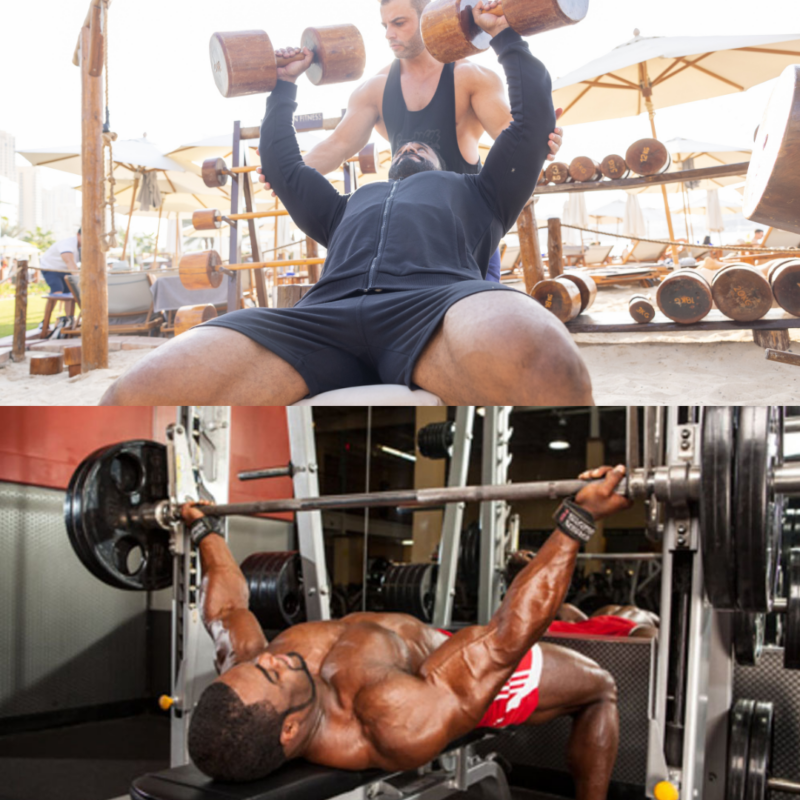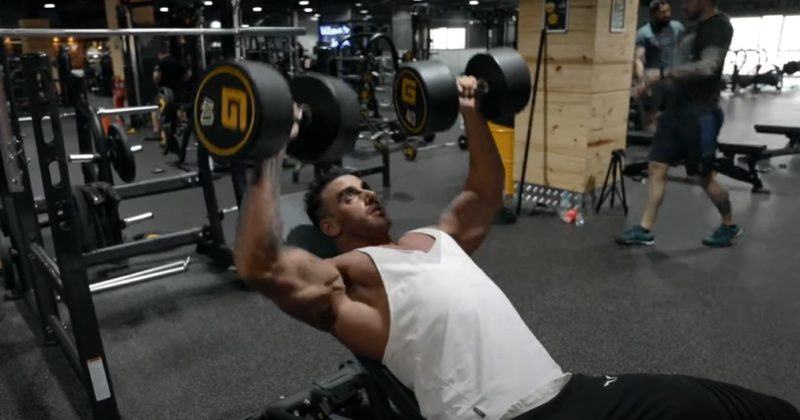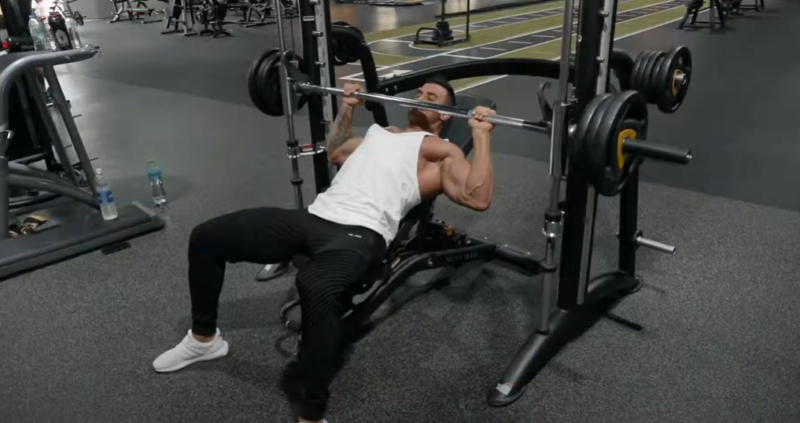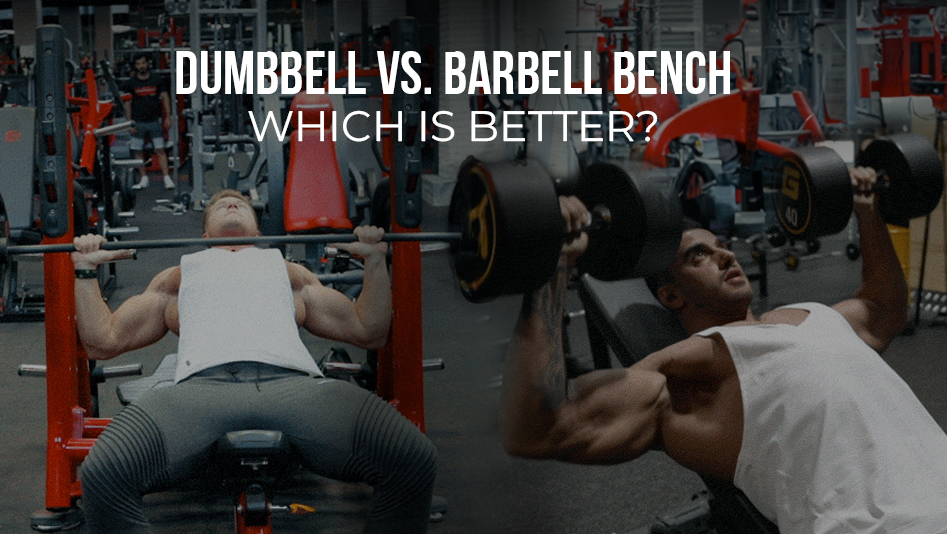Dumbbell Bench Vs Barbell Bench—In a Glance
Here comes Monday again – the official Chest Day at the gym – and you’re not sure which one to go for: Dumbbell or Barbell Bench Press?
The question of which one’s better between dumbbell vs barbell bench press is a debate as old as time in gym context. While the barbell is a powerhouse move, adored by many gym buffs as it builds both strength and mass, the dumbbell bench press is a great substitute for this exercise.
The one you choose depends on your strength, fitness goals, accessibility and workout routine.
However, this is not the end of it. In fact, the difference between dumbbell and barbell bench press is more than just that of the equipment.
The main difference between dumbbell and barbell bench press is that with dumbbells, you get more unilateral movement, better range of motion and stability. Whereas with a barbell, while your range of motion is limited, you’re able to lift 20% heavier than with a dumbbell.
Ready to powerpack your chest day workout? Let’s dive deeper!
Dumbbell & Barbell Bench Press Difference | How To Do Dumbbell Bench Press | How To Do Barbell Bench Press | Conclusion | FAQs
The Difference Between Dumbbell and Barbell Bench Press

Range Of Motion
Although it varies from lifter to lifter, you get much better range of motion during dumbbell bench press than with barbell bench press.
When you lower the dumbbells during your eccentric, you’re able to lower the weight all the way down to your sides. This fully stretches out your pecs during the negative, helping you activate it completely when you push again. During the barbell press, you cannot achieve this because your movement is restricted by the bar.
In addition, when you push the dumbbells during your lift, you can squeeze your pecs by bringing your arms together for exceptional contraction. You cannot do this with the barbell.
Develop rounded pecs with these 7 inner chest exercises.
Muscle Activation
Both the dumbbell and bench press work your pecs, delts and triceps muscles. However, the impact on each muscle group is slightly different for each variation.
Chest (Pectoralis Major)
- Since the dumbbell press offers a better range of motion, your pecs fully stretch out at the bottom leading to better pec activation.
- With the barbell bench press, there’s consistent tension in your pecs, making this variation incredible for your upper chest activation.
Learn how to do incline dumbbell press properly.
Triceps (Triceps Brachii)
- Since your triceps are connected to your arms, they get worked during your push. However, since there’s a better range of motion with dumbbells, your pecs are mainly worked, which means your triceps aren’t as engaged.
- With the limited range of motion in barbells, your movement is fixed and strict, which works your triceps as your elbows push the barbell during the lift.
Activate your triceps before barbell bench press with triceps pushdowns.
Deltoids (Anterior Deltoids)
- Although dumbbells offer an isolated engagement for your pecs, they engage your anterior delts as they stabilize your lift. This gives you that shoulder burn during your dumbbell bench press.
- Since barbell bench press is strict and requires a fixed motion, it engages your delts as well.
Build stronger shoulders with these 3 deltoid exercises.
Performing The Exercise
Executing barbell and dumbbell bench press is more or less similar. You push with your chest while pinching your shoulders blades together, driving them into the bench. However, the way your arms move during the push and the eccentric is different.
- Arm Movement with Dumbbells: Your elbows are tucked slightly toward your sides. As you lower the dumbbells, you bring your forearms farther from one another. When you press, you push squeeze your chest, bringing your arms together.
- Arm Movement with Barbell: Your hands remain in the same position, moving up and down consistently.
Learn how to perform wrist curls for stronger forearms.
How To Do Dumbbell Bench Press?

Step-By-Step:
- Sit down at the edge of a bench with the dumbbells on your knees
- Push the weights with your knees, one dumbbell at a time and tuck them into your chest
- Place your feet on the floor – make sure your feet are stable
- Brace your core as you lay down on the bench
- Roll your shoulder blade back and ground them into the bench
- As your drift your elbows to the side, you’ll feel tension building in your pecs
- Keep your elbows tucked into your sides to align with your chest
- With vertical forearms, start lifting the weights in a slight curve, bringing them right above your shoulders
- As you lower back down, allow your shoulder blades to retract
Rep 10-12 times, depending on the weight and your strength
Building your upper chest? Do these 5 chest exercises to get those superman pecs!
Pros of Doing Dumbbell Bench Press
- It improves your arm balance as each lift is an isolated movement
- It allows you to train your chest intensely even with lower weights, helping you gain mass without the injury risks of heavy lifting
- It allows you to have a neutral grip, engaging your chest more than your wrist, elbows and shoulder joints
Don’t have equipment? Try this explosive chest workout at home!
General Dumbbell Bench Press Guideline According to Your Goal
| Goal/Level | Beginner | Intermediate | Advanced |
| Body Building | |||
| Sets | 3 | 4 | 5 |
| Reps | 12-15 | 8-12 | 6-8 |
| Rest Period | 1-1.5 minutes | 1-1.5 minutes | 1-1.5 minutes |
| Weight | Light (Focus on form) | Moderate (Challenging but maintainable for all reps) | Heavy (Challenging for the first few reps) |
| Hypertrophy | |||
| Sets | 3 | 4 | 5 |
| Reps | 8-12 | 6-10 | 4-8 |
| Rest Period | 1.5-2 minutes | 1.5-2 minutes | 2-2.5 minutes |
| Weight | Moderate (It should be challenging by the last few reps) | Moderate-Heavy (Maintain form but push boundaries) | Heavy (Maintain form but really challenge muscles) |
| Powerlifting | |||
| Sets | 5 | 6 | 7 |
| Reps | 5 | 3-5 | 1-3 |
| Rest Period | 2-3 minutes | 2.5-3.5 minutes | 3-5 minutes |
| Weight | Moderate (Focus on explosive lift with good form) | Heavy (Maintain explosiveness with challenging weight) | Very Heavy (Lifting near maximal effort) |
Remember, this table is a general guideline. You should always tailor your workouts based on your fitness level, goal and lifting ability.
Not comfortable with weights? You can train your chest with these 4 resistance bands chest workouts!
How To Do Barbell Bench Press?

Step-By-Step:
- Sit down at the edge of a bench with a wide stance
- Make sure your toes are pointed outward
- Your legs should be at a 90° angle and your eyes should be directly under the bar
- Prop yourself up on your upper back, retracting your shoulder blades into the bench
- You should have a significant arch in your lower back
- Push your heels into the ground to create tension in your glutes
- Place the heels of your palms under the bar and take your grip from there
- Your forearms should be slightly farther than shoulder-width apart
- Push the bar up and bring it directly over your shoulders
- Lower the bar down and bring it right on to your chest (sternal)
- Lift it back up, squeezing your pecs together
Rep 10-12 times to complete one set.
Want fully rounded pecs? Try these 8 lower pec exercises to achieve a sculpted chest.
Pros of Doing Barbell Bench Press
- It allows you to lift 20% heavier weight compared to dumbbell bench press
- It works a vast range of muscle groups including your chest, triceps, lats, shoulders and even biceps, giving you not just mass but also upper body strength
Want to engage multiple muscle groups in one move? Learn how to do cable crossovers correctly.
General Barbell Bench Press Guideline According To Your Goal
|
Goal/Level |
Beginner | Intermediate | Advanced |
|
Body Building |
|||
|
Sets |
3 | 4 |
5 |
| Reps | 12-15 | 8-12 | 6-8 |
|
Rest Period |
1-1.5 minutes | 1-1.5 minutes |
1-1.5 minutes |
|
Weight |
Light (Focus on form) | Moderate (Challenging but maintainable for all reps) |
Heavy (Challenging for the first few reps) |
|
Hypertrophy |
|||
|
Sets |
3 | 4 |
5 |
|
Reps |
8-12 | 6-10 |
4-8 |
| Rest Period | 1.5-2 minutes | 1.5-2 minutes |
2-2.5 minutes |
|
Weight |
Moderate (It should be challenging by the last few reps) |
Moderate-Heavy (Maintain form but push boundaries) |
Heavy (Maintain form but really challenge muscles) |
|
Powerlifting |
|||
|
Sets |
5 | 6 | 7 |
| Reps | 5 | 3-5 |
1-3 |
| Rest Period | 2-3 minutes | 2.5-3.5 minutes |
3-5 minutes |
|
Weight |
Moderate (Focus on explosive lift with good form) | Heavy (Maintain explosiveness with challenging weight) |
Very Heavy (Lifting near maximal effort) |
Again, always tailor your workouts according to your fitness goals!
Ladies, want perkier chest? Try these 5 chest workouts for women!
Dumbbells Vs Barbell Bench Press – Which One’s Better?
While you should incorporate both variations in your chest workout routine, it is safe to say that dumbbells win this battler. This is primarily because they promote a better range of motion, improve mobility, provide added chest stretch and are safe as well.
On the other hand, barbell bench press has its own merits such as allowing you to lift heavier while engaging multiple muscles at once.
For the best chest gains, rotate between both variations in your chest days to keep your workouts unique and exciting!
Not sure if you’re hitting your chest muscles right or not? Discover some tips to build an incredible upper chest!
Frequently Asked Questions
Are dumbbells better than barbells?
The answer depends on your fitness goals. If your goal is muscle hypertrophy, upper body strength and building mass in your chest, then barbell bench press is great for you. On the other hand, if you’re goal is bodybuilding or weightlifting, then dumbbells are a great choice because they help you build your pecs with lesser weights thanks to an enhanced range of motion, stability and improved isolated pec activation.
When to switch from dumbbell to barbell?
Once again, when to switch from dumbbell to barbell depends on your lifting abilities. However, it is usually recommended to do your barbell bench presses before dumbbell benches because you can overload on the barbell and lift heavier. Once you’re done with your heavy lifts, you can switch to dumbbells for endurance style training and muscle building.
Can you use dumbbells instead of barbells?
Yes you can use dumbbells instead of barbells for your bench presses or any other workouts. However, having a holistic workout routine means not only doing different exercises and their variations, but also incorporating different equipment into your routine. If you don’t have a barbell accessible, you can always stick with dumbbells only workouts.
The answer depends on your fitness goals. If your goal is muscle hypertrophy, upper body strength and building mass in your chest, then barbell bench press is great for you. On the other hand, if you’re goal is bodybuilding or weightlifting, then dumbbells are a great choice because they help you build your pecs with lesser weights thanks to an enhanced range of motion, stability and improved isolated pec activation.
Once again, when to switch from dumbbell to barbell depends on your lifting abilities. However, it is usually recommended to do your barbell bench presses before dumbbell benches because you can overload on the barbell and lift heavier. Once you’re done with your heavy lifts, you can switch to dumbbells for endurance style training and muscle building.
Yes you can use dumbbells instead of barbells for your bench presses or any other workouts. However, having a holistic workout routine means not only doing different exercises and their variations, but also incorporating different equipment into your routine. If you don’t have a barbell accessible, you can always stick with dumbbells only workouts.

